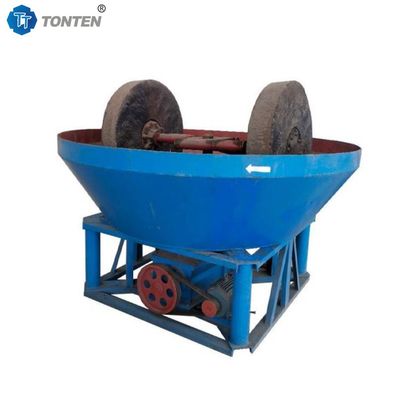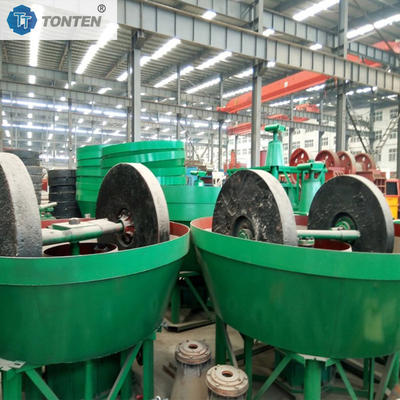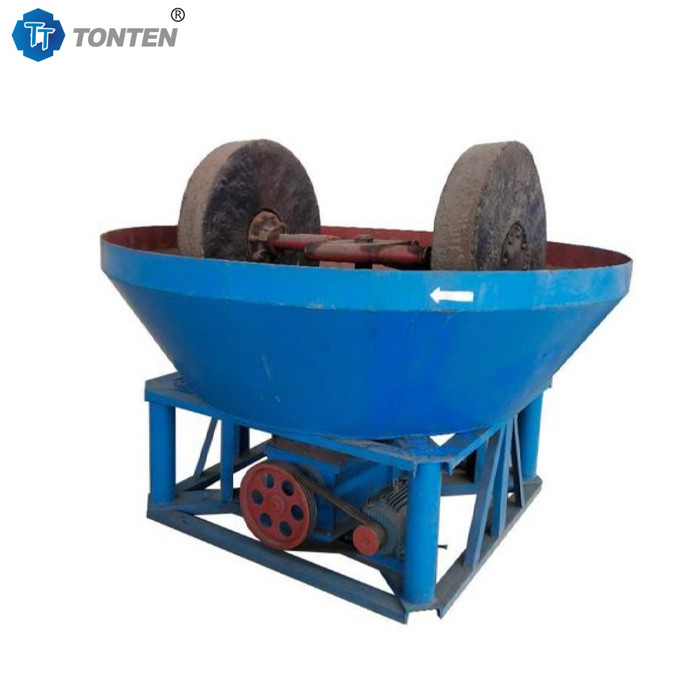Mining Gold Silver Wet Pan Mill Ore Rollers Grinding Mill Machine
Product Details:
| Place of Origin: | China |
| Brand Name: | TONTEN |
| Model Number: | TT-1600 |
Payment & Shipping Terms:
| Minimum Order Quantity: | 1 Set |
|---|---|
| Price: | Negotiable |
| Packaging Details: | Export standard wooden box packaging or container |
| Delivery Time: | 7-10 work days |
| Payment Terms: | T/T |
| Supply Ability: | 20 sets per month |
|
Detail Information |
|||
| Working Diameter Of Grinding Disc: | 1600MM | Matching Motor Power: | 18.5 KW / 25 HP |
|---|---|---|---|
| Spindle Speed: | 22 ± 2 Rpm | Ore Processing Capacity: | 2-4tph |
| Maximum Feed Size: | ≤ 30 Mm | Discharge Size Range: | 100-200 Mesh (adjustable) |
| Number And Size Of Rollers: | 2 Ø500mm × 450mm | Type: | Mining Gold Silver Wet Pan Mill |
| Highlight: | wet pan mill gold mining machine,silver ore grinding mill,mineral processing wet pan mill |
||
Product Description
Mining Gold Silver Wet Pan Mill Ore Rollers Grinding Mill Machine
Overview:
Gold mills, often called wet mills, typically operate using a wet process. They are a traditional mining equipment that combines grinding, stirring, and mixing functions. They utilize the rotation of two large rollers on a platen, creating powerful static pressure and shear forces to grind the ore into a fine powder. Water is added during the process to form a slurry for uniform mixing. TONTEN gold mills are used for grinding precious and rare metal ores such as gold, silver, lead, zinc, antimony, and tungsten. They are particularly well-suited for gold extraction using the amalgamation process. They are common equipment in small and medium-sized ore processing plants, laboratories, and even in traditional ore processing.
Core Structural Components:
1. Millstone (Chassis): This is a solid, disc-shaped, fixed base lined with a replaceable wear-resistant lining (such as high-manganese steel). It serves as the working platform for the ore and water, and is where the grinding process occurs.
2. Roller (Grinding Wheel): Typically two solid, heavy iron wheels (also lined with a wear-resistant material), these are the primary grinding components. The rollers are mounted on a boom (roller arm) via bearings, which in turn is connected to the central spindle.
3. Drive System:
1) Motor: Provides power.
2) Reducer: Reduces the motor's high speed to the low, torque-rich speed (typically 20-30 rpm) required by the roller.
3) Vertical Shaft (Main Shaft): The reducer rotates the vertical shaft, which in turn drives the boom and roller mounted on it, which revolve around the center of the millstone. At the same time, the roller will also rotate around its own axis under the action of friction with the ore.
Working Principle:
The operating process can be summarized as "revolution plus rotation, combining compression and grinding":
Feeding: Initially crushed ore (generally ≤30mm in size) and water are added to the grinding plate in a specific ratio.
Starting: The motor starts, driving the arm and two rollers in a slow but powerful circular motion (revolution) along the grinding plate through the transmission system.
Grinding: Compression: The heavy rollers, with their immense weight, exert strong static pressure on the ore on the grinding plate, crushing it.
Shearing and Grinding: Due to the speed difference and friction between the rollers and the material, the rollers simultaneously rotate, causing rolling, shearing, and grinding of the material. This combined "rolling + grinding" effect results in high grinding efficiency and uniform particle size.
Agitation and Mixing: During the grinding process, the equipment continuously stirs the slurry, ensuring full contact between the reagents (such as mercury or sodium cyanide) and the mineral particles, which is crucial for subsequent extraction processes. Discharge: When the material is ground to the required fineness (usually 100-200 mesh), it is discharged through the discharge port on the side wall of the grinding plate and enters the next sorting process.
![]()
Specification:
|
Model
|
Feeding size
(mm)
|
Output size
(mm)
|
Capacity
(t/h)
|
Speed
(r/min)
|
Motor power
(kw)
|
Weight
(kg)
|
|
900
|
<15
|
0.6-0.07
|
0.3
|
17-19
|
5.5
|
3500
|
|
1000
|
<20
|
0.6-0.07
|
0.5
|
16-18
|
5.5
|
4800
|
|
1100
|
<20
|
0.6-0.07
|
0.6-0.8
|
16-18
|
7.5
|
5200
|
|
1200B
|
<20
|
0.6-0.07
|
0.8-1.2
|
16-18
|
7.5
|
5530
|
|
1200A
|
<20
|
0.6-0.07
|
1-1.3
|
21-23
|
7.5
|
5500
|
|
1300
|
<20
|
0.6-0.07
|
1.5
|
16-18
|
15
|
7600
|
|
1400
|
<20
|
0.6-0.07
|
1.5-2
|
16-18
|
18.5
|
8550
|
|
1500B
|
<30
|
0.6-0.07
|
2.5-3
|
20-22
|
22
|
12000
|
|
1600
|
<30
|
0.6-0.07
|
4-5
|
20-22
|
30
|
14600
|






